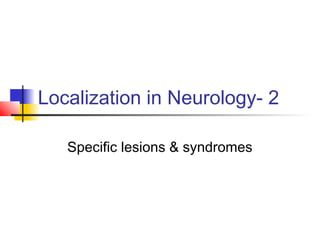
Localization in neurology 2
- 1. Localization in Neurology- 2 Specific lesions & syndromes
- 2. Lesion- CNS Upper motor neuron Weakness Disuse atrophy Spasticity Reflexes Extensor plantar NCV- normal No denervation potentials in EMG Lower motor neuron Weakness Wasting-marked & early Flaccidity Loss of reflexes Fasciculations NCV- abnormal Denervation potentials in EMG
- 3. Lesion- brain UMN Spasticity UL-flexor, LL-extensor Paralysis of voluntary movements No involuntary move. Exaggerated DTR Plantar-extensor EPS Rigidity All-flexor>extensor Mildly decreased voluntary movements Involuntary movements Normal DTR Plantar-flexor
- 4. Localization in spinal cord Uppermost sensory level Pain over a vertebra Radicular pain Band-like sensation Isolated flaccidity/atrophy/areflexia & distal UMN signs
- 5. Lesion- spinal cord Extramedullary Radicular pain Localised vertebral t’ness Brown-Sequard hemicord syndrome Early UMN signs Ascending sensory symp. Sharp sensory level Marked sacral sensory loss Early CSF abnormalities Intramedullary Poorly localised burning pain Dissociated loss of pain, with spared joint position sense Late UMN signs Commom coexistence of LMN+UMN signs Descending sensory symp. Sacral sparing Normal/minimally altered CSF
- 6. Lesion- lower spinal cord Cauda equina Pain common, projected to perineum/thigh LMN type paraparesis Asymmetric Saddle anaesthesia Late bladder & bowel involvement Conus medullaris Pain less prominent Absent anal reflex More symmetrical B/L saddle anesthesia Early bladder & bowel involvement and impotence
- 7. MCA infarct Embolic Contralateral hemiplegia &/or hemianaesthesia Dominant hemisphere- aphasia Non-dominant hemisphere- agnosia & apraxia
- 8. Basilar artery infarct Mostly embolic Bilateral long tract signs- sensory & motor With cranial nerve- V-VIII- symptoms With cerebellar dysfunction
- 9. Medullary syndromes Lateral Trigeminal sensory nucleus & spinothalamic tracts affected Causing I/L face & C/L body loss of pain & temperature sensation Ataxia, nystagmus, vertigo, dysphagia, hoarseness Horner’s syndrome- ptosis, miosis, I/L anhidrosis Medial Hypoglossal nerve, medullary pyramids & medial leminiscus affected Causing I/L tongue deviation, C/L hemiplegia & C/L loss of touch/position/vibration sensation
- 10. Bulbar palsy B/L LMN defect of IX-XII cranial nerves Dysphagia (liquid>solid), nasal regurgitation, slurred speech Nasal speech, wasted tongue with fasciculation, absent gag reflex Pseudobulbar palsy- B/L UMN defect of IX-XII cranial nerves Dysphagia, dysarthria, emotional lability Slow indistinct speech, spastic tongue, brisk jaw jerk Frontal release signs
- 11. Craniovertebral junction anomaly Neck/shoulder pain Short, webbed neck with ROM Vertigo, drop attacks, syncope- due to vertebrobasilar ischemia Upper cord compression- spastic paresis, posterior column defects ± Lhermitte sign Brain compression- nystagmus, hoarseness, dysarthria, dysphagia, ataxia
- 12. Spinal cord Transverse myelitis Upper sensory level for all sensations, LMN signs at the level of lesion, flaccid paralysis (spinal shock)UMN signs distally, B/B involved Anterior spinal artery syndrome Upper sensory level for pain/temperature, sparing of posterior columns, UMN signs distally Brown-Sequard syndrome I/L spastic paralysis & loss of joint/position sense, C/L loss of pain/temperature sensation
- 13. Motor neuron disease Selectively affect motor neurons, that control voluntary muscle activity Types- Amyotrophic lateral sclerosis- UMN+LMN Primary lateral sclerosis- UMN Progressive muscular atrophy- LMN Bulbar palsy- bulbar LMN Pseudobulbar palsy- bulbar UMN
- 14. Inflammatory demyelinating polyneuropathy Acute- AIDP Symmetric ascending weakness, cranial n. may be involved, areflexia, myalgia With or without dysesthesias, loss of position sense more common & severe than loss of pain/temp. Autonomic dysfunction- orthostatic hypotension Chronic- CIDP- >8 weeks
- 15. In the end Neuromuscular junction- Symmetrical proximal muscle weakness, with bulbar involvement Fatigable, variable Sensory, reflexes, bladder-bowel- normal Myopathy- Symmetrical proximal muscle weakness, bulbar spared Progressive, waddling gait Sensory, reflexes, bladder-bowel- normal
